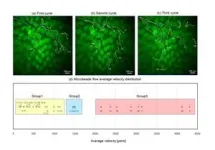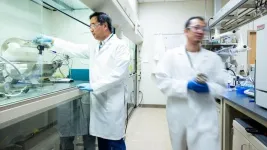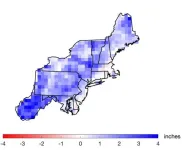(Press-News.org) (MEMPHIS, Tenn. – May 29, 2023) St. Jude Children’s Research Hospital scientists discovered how the current epizootic H5N1 avian influenza virus (bird flu) gained new genes and greater virulence as it spread west. Researchers showed that the avian virus could severely infect the brains of mammalian research models, a notable departure from previous related strains of the virus. The researchers genetically traced the virus’ expansion across the continent and its establishment in wild waterfowl populations to understand what makes it so different. The study was recently published in Nature Communications.
“We haven’t seen a virus quite like this one,” said corresponding author Richard Webby, Ph.D., St. Jude Department of Infectious Diseases. “In 24 years of tracing this particular H5N1 flu lineage, we haven’t seen this ability to cause disease but also be maintained in these wild bird populations.”
When the scientists tested the newer avian flu strains for their ability to cause disease in mammals by infecting a ferret model, they found an unexpectedly high amount of pathogenicity.
“Some of these are really nasty viruses,” Webby said. “There’s a huge amount of the virus in the brain of infected animals. That’s the hallmark of what we saw with these flu strains — increased pathogenicity associated with high virus load in the brain. That’s not the first time we’ve seen H5 viruses in the brain, but these are probably some of the most virulent we’ve looked at over 24 years of following these viruses.”
Previous influenza viruses that caused severe disease in North America “burned out” in their main host bird population, and the outbreaks ended quickly. This current strain was detected at high levels in sick chickens but has expanded into other species.
“This is not just a chicken virus now,” Webby said. “It’s also infecting other avian and mammal species in the U.S. It’s a higher exposure risk for humans and other mammals than we’ve ever had in North America. We’ve never really been exposed to this level of circulation of these highly pathogenic flu viruses.”
A low risk to humans (for now)
While the newer strains of this H5N1 influenza show a greater ability to cause disease in mammals than earlier viruses, the scientists found it to be low-risk to humans. This is because the virus appears well-adapted to transmit between birds rather than between mammals.
“Overall, their risk to humans is still low,” Webby said. “But that risk does seem to be changing, and these viruses are doing things that we haven’t seen H5s do before. They’ve come into the continent’s wild bird population, they’ve reassorted, and they’ve been maintained over time. There are now many different types out there, and they're very nasty.”
Even though the risk of spreading infection is low, the research suggests humans should be cautious interacting with wildlife.
“Someone would have to work pretty hard to infect themselves with this virus. But if they do happen to be infected, there’s a real chance of getting a severe disease from it,” Webby said. “People just need to be careful and remember that some of the wild animals out there potentially harbor these highly pathogenic viruses.”
Genetic change supercharges spread and severity
In the past, similar strains of influenza viruses have not caused similarly severe diseases, nor have they become far-flung in wild bird populations. Since the new strains have done so much more damage, the scientists looked for what was different. The group identified the direct ancestor to the current strains, which spread from Europe to the Americas after gaining a different version of the viral protein, neuraminidase. This new protein increased the virus’s ability to transmit between birds. Then it arrived on the East Coast of Canada and traveled to the United States.
As the researchers studied the virus further, they pinpointed which viruses — distinct from previous ones —caused the current outbreaks. They found that after reaching North America, the virus rapidly changed again to become more virulent. It mixed with flu viruses in North American wild birds, swapping several genes. This reassortment of genes had two effects. One, the virus seemed to become even more adapted to the bird population, infecting many different types of birds. This included atypical hosts, such as buzzards and eagles, which typically do not get the flu. Second, the virus gained its severe disease-causing properties.
“The surprising thing was that just a few reassortment events did change these viruses’ ability to cause disease in our models,” Webby said. “And those events generated many different genotypes from that mixing. Then those viruses spread and have now become established in the North American wild bird population.”
Webby’s group and others continue to monitor the ongoing avian flu pandemic globally to assess its continually evolving risk to both humans and birds.
Authors and funding
The study’s co-first authors are Ahmed Kandeil, Christopher Patton, Jeremy Jones, Trushar Jeevan and Walter Harrington, all of St. Jude. The other authors are Sanja Trifkovic, Jon Seiler, Thomas Fabrizio, Karlie Woodard, Jasmine Turner, Jeri-Carol Crumpton, Lance Miller, Adam Rubrum, Jennifer DeBeauchamp, Charles Russell, Elena Govorkova, Peter Vogel and Lisa Kercher, St. Jude; Mia Kim-Torchetti, National Veterinary Services Laboratories, Animal and Plant Health Inspection Service (APHIS), US Department of Agriculture (USDA); Yohannes Berhane, National Centre for Foreign Animal Disease and the University of Manitoba and David Stallknecht and Rebecca Poulson, The University of Georgia.
The study was supported by grants and contracts from the National Institute of Allergy and Infectious Diseases (HHSN272201400006C, 7 5N93021C00016 and R01AI150745), the National Science Foundation (1911955) and ALSAC, the fundraising and awareness organization of St. Jude.
St. Jude Media Relations Contacts
Michael Sheffield
Desk: (901) 595-0221
Cell: (901) 379-6072
michael.sheffield@stjude.org
media@stjude.org
St. Jude Children's Research Hospital
St. Jude Children's Research Hospital is leading the way the world understands, treats and cures childhood cancer, sickle cell disease and other life-threatening disorders. It is the only National Cancer Institute-designated Comprehensive Cancer Center devoted solely to children. Treatments developed at St. Jude have helped push the overall childhood cancer survival rate from 20% to 80% since the hospital opened more than 60 years ago. St. Jude shares the breakthroughs it makes to help doctors and researchers at local hospitals and cancer centers around the world improve the quality of treatment and care for even more children. To learn more, visit stjude.org, read St. Jude Progress blog, and follow St. Jude on social media at @stjuderesearch.
END
Genetic change increased bird flu severity during U.S. spread
Scientists at St. Jude Children’s Research Hospital have discovered H5N1 avian influenza viruses gained the ability to cause severe disease and target the brain in mammals as they spread across North America.
2023-05-31
ELSE PRESS RELEASES FROM THIS DATE:
New Jersey Health Foundation awards grants to Kessler Foundation to advance research in brain and spinal cord stimulation methods
2023-05-30
East Hanover, NJ – May 30, 2023 – Annually, New Jersey Health Foundation (NJHF) invites researchers to submit applications for grants aimed at supporting pilot research projects that exhibit promising potential. These grants serve as opportunities for scientists to utilize their initial findings to secure further funding and progress their research. This year, NJHF granted awards to two Kessler Foundation scientists to conduct studies that expand research in upper extremity exercise after stroke ...
Extracting a clean fuel from water
2023-05-30
A plentiful supply of clean energy is lurking in plain sight. It is the hydrogen we can extract from water (H2O) using renewable energy. Scientists are seeking low-cost methods for producing clean hydrogen from water to replace fossil fuels, as part of the quest to combat climate change.
Hydrogen can power vehicles while emitting nothing but water. Hydrogen is also an important chemical for many industrial processes, most notably in steel making and ammonia production. Using cleaner hydrogen is highly desirable in those industries.
“By using ...
NJIT researchers awarded $4.6m to unlock mysteries of solar eruptions
2023-05-30
A New Jersey Institute of Technology research team led by physics professor Wenda Cao at the university’s Center for Solar Terrestrial Research (CSTR) has been awarded a $4.64 million National Science Foundation grant to continue leading explorations of the Sun’s explosive activity at Big Bear Solar Observatory (BBSO).
The grant marks the largest project that the Solar-Terrestrial Research Program under NSF’s Division of Atmospheric and Geospace Sciences (AGS) supports, extending five more years of baseline funding for all science, instrumentation and education activities at BBSO, located at California’s Big Bear Lake.
The ...
Extended lymph node removal does not benefit patients with clinically localized muscle-invasive bladder cancer
2023-05-30
An extended lymphadenectomy – removal of additional lymph nodes beyond the extent of the standard procedure – in patients undergoing radical cystectomy (removal of bladder and nearby tissues) because of clinically localized muscle-invasive bladder cancer provides no patient benefit as measured by disease-free survival or overall survival times. It does, however, increase the risk of adverse events (side effects) and post-surgical death.
These primary results from the phase 3 SWOG S1011 clinical ...
Study finds sex education tool improves reproductive health knowledge among adolescent girls
2023-05-30
HUNTINGTON, W.Va. – A Marshall University study found that a virtual sex education tool improved reproductive health knowledge scores and measures of self-efficacy among adolescent girls.
The findings, published last month in Sex Education, a leading international journal on sex, sexuality and relationships in education, found that sexual health knowledge scores on a validated scale increased among participants, along with improved measures of self-efficacy regarding birth control, healthy relationships and sexually transmitted infection (STI) prevention. Notably, ...
No-till revolution could stop Midwest topsoil loss in its tracks
2023-05-30
American Geophysical Union
25 May 2023
AGU Release No. 22
For Immediate Release
This press release and accompanying multimedia are available online at: https://news.agu.org/press-release/no-till-revolution-could-stop-midwest-topsoil-loss-in-its-tracks/
No-till revolution could stop Midwest topsoil loss in its tracks
If Midwestern farms all adopted low-intensity tilling practices or stopped tilling entirely, the erosion of critical topsoil could decrease by 95% in the next 100 years, new study finds
AGU press contact:
Rebecca ...
Computational method uncovers the effects of mutations in the noncoding genome
2023-05-30
Less than two percent of the human genome codes for proteins, with the rest being noncoding and likely helping with gene regulation. Mutations in the noncoding genome often trigger trait changes that cause disease or disability by altering gene expression. However, it can be hard for scientists to track down which of numerous variants associated with a disease or other complex trait are the causal ones and to understand the mechanism of their effects. Researchers at the Brigham developed a new computational approach that hones in on small regions of the noncoding genome that genome-wide association studies (GWAS) identified ...
Extreme precipitation in northeast to increase 52% by the end of the century
2023-05-30
With a warmer climate creating more humid conditions in the Northeast, extreme precipitation events — defined as about 1.5 or more inches of heavy rainfall or melted snowfall in a day — are projected to increase in the Northeast by 52% by the end of the century, according to a new Dartmouth study.
The findings are published in Climatic Change.
"As climate change brings warmer temperatures, you have more water vapor in the atmosphere, which creates the right conditions for extreme precipitation," says first author Christopher J. Picard '23, an earth sciences major and undergraduate researcher in the Applied Hydroclimatology Group ...
Lung infection may be less transmissible than thought
2023-05-30
A little-known bacterium — a distant cousin of the microbes that cause tuberculosis and leprosy — is emerging as a public health threat capable of causing severe lung infections among vulnerable populations, those with compromised immunity or reduced lung function.
Recent research found that various strains of the bacterium, Mycobacterium abscessus, were genetically similar, stoking fears that it was spreading from person to person.
But a new study by Harvard Medical School researchers published ...
Experimental decoy protects against SARS-CoV-2 infection
2023-05-30
An experimental “decoy” provided long-term protection from infection by the pandemic virus in mice, a new study finds.
Led by researchers at NYU Grossman School of Medicine, the work is based on how the virus that causes COVID-19, SARS-CoV-2, uses its spike protein to attach to a protein on the surface of the cells that line human lungs. Once attached to this cell surface protein, called angiotensin converting enzyme 2 (ACE2), the virus spike pulls the cell close, enabling the virus to enter the cell and hijack its machinery to make viral copies.
Earlier in the pandemic, pharmaceutical ...
LAST 30 PRESS RELEASES:
Shingles vaccine linked to slower biological aging in older adults
A self-assembling shortcut to better organic solar cells
A two-week leap in breeding: Antarctic penguins’ striking climate adaptation
Climate risks to insurance and reinsurance of global supply chains
58% of patients affected by 2022 mpox outbreak report lasting physical symptoms
Golden Gate method enables rapid, fully-synthetic engineering of therapeutically relevant bacteriophages
Polar weather on Jupiter and Saturn hints at the planets’ interior details
Socio-environmental movements: key global guardians of biodiversity amid rising violence
Global warming and CO2 emissions 56 million years ago resulted in massive forest fires and soil erosion
Hidden order in quantum chaos: the pseudogap
Exploring why adapting to the environment is more difficult as people age
Society for Laboratory Automation and Screening welcomes new scientific director: Madeline M. Farley, Ph.D.
Austrian cow shows first case of flexible, multi-purpose tool use in cattle
Human nasal passages defend against the common cold and help determine how sick we get
Research alert: Spreading drug costs over the year may ease financial burden for Medicare cancer patients
Hospital partnership improves follow up scans, decreases long term risk after aortic repair
Layered hydrogen silicane for safe, lightweight, and energy-efficient hydrogen carrier
Observing positronium beam as a quantum matter wave for the first time
IEEE study investigates the effects of pointing error on quantum key distribution systems
Analyzing submerged fault structures to predict future earthquakes in Türkiye
Quantum ‘alchemy’ made feasible with excitons
‘Revoice’ device gives stroke patients their voice back
USF-led study: AI helps reveal global surge in floating algae
New method predicts asthma attacks up to five years in advance
Researchers publish first ever structural engineering manual for bamboo
National poll: Less than half of parents say swearing is never OK for kids
Decades of suffering: Long-term mental health outcomes of Kurdish chemical gas attacks
Interactional dynamics of self-assessment and advice in peer reflection on microteaching
When aging affects the young: Revealing the weight of caregiving on teenagers
Can Canada’s health systems handle increased demand during FIFA World Cup?
[Press-News.org] Genetic change increased bird flu severity during U.S. spreadScientists at St. Jude Children’s Research Hospital have discovered H5N1 avian influenza viruses gained the ability to cause severe disease and target the brain in mammals as they spread across North America.






